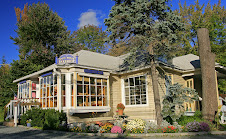God knows, I have to endure lectures from people who've never tried my breads telling me about some big bakery in some mid-sized town, and how superior their bread is to anything I can produce. Fact is, the leftovers languishing in my freezer, if popped in the oven for ten minutes, far excel just about anything belched from the machines of most large bakeries. And here's why: those huge shops have to move the product out FAST, so, instead of allowing their doughs to ferment naturally, they shovel chemicals into it ("Dough Conditioner" on the label), let it rest 30 minutes, put it in the divider, shape it, proof it and bake it. All in a couple of hours.
Not so in our shop. The craft of the baker is based largely upon his ability to control and manipulate fermentation in order to achieve specific results. I'm going to make a list of some of my breads and the ferments involved, editing them as I discover something new. And, since nobody other than blood relatives and people trying to sell me shit ever read this blog, I have no fear of anyone stealing my "secrets". (Not that anything to follow is original, mind you, it's mostly a concentrate of research from many different places. I may have observed something in my work, but no doubt it has been observed and noted before.)
Italian
Flour, water, yeast, sea salt, malt syrup.
A straight dough, it will smell grassy as it first begins to ferment, then develop a fruity aroma. Both of these stages are too young to render an excellent bread. The dough will take on the smell of beer after that, which will grow stronger over the course of about an hour. This is the time to do the make-up and, if not, the dough will get old, it's aroma taking on the sting of alcohol, the reek of beer overpowering.
After making up the loaves and rolls, they are retarded overnight with their final proof occurring in the refrigerator. This slow ferment changes everything about the final bread: the crust, the flavor, the oven spring. The loaves are peeled into the oven directly from the retarder, and an hour later as I shovel the bread onto cooling racks, the smell of fermentation is still readily discernible.
Baguette
Preferment: Soft flour, water, a trace of yeast.
As the name suggests, part of the batch is fermented first. The ingredients are mixed into a batter and, in my shop, allowed to ferment overnight at an elevated temperature, around 90f. The next day, a wallop of alcohol will come from it as the lid is lifted; if not, it is allowed more time until the sting of alcohol does develop.
Dough: Preferment, strong flour, yeast, sea salt, whole wheat flour.
Mixed into dough, with an autolyze before the yeast and salt are added, and given one turn halfway through the bulk ferment. The dough is gassy and delicate.
The loaves are given a quick mise en tourne as they are cut, then full shaping, and long bench rests as they are gradually elongated into baguettes. They are retarded overnight on linen couches, given a final proof with plenty of humidity, and baked in a very hot oven with steam. The aroma of fermentation permeates the finished loaves, and they are remarkably crusty.
UPDATE: WE NOW USE THREE PREFERMENTS.
UPDATE: WE NOW USE THREE PREFERMENTS.
Sourdough
Sour starter, flour, water, whole wheat flour, sea salt.
Starter requires about as much care as a puppy. It needs to be fed three times a day, hydrated with filtered water, and stirred frequently to give it plenty of oxygen. The balance of white and wheat flours must be exact in order to give it the proper balance of sweet, complex tang, and beer flavors. It will be kept at room temperature, or in a warm spot, or refrigerated, depending on it's mood. Moodiness is more like it. But oh, what breads you can coax from it!
Once the water temperature is determined for a batch of sourdough, it is mixed, with an autolyze ( 20 minute rest ) before adding the salt. Bulk fermenting to thrice it's original volume, this dough usually requires between three and four hours to ripen. It is scaled up, given a mise en tourne, rested, then given it's final boule shape. The loaves are proofed to half the desired size in an hour or two at about 80f with moderate humidity, then retarded overnight. Next, they are given a final proof in the same conditions as the first proof, then baked in a moderately hot oven with steam. The crust smells of citrus, caramel, and toasted pecan; the crumb has a subtle, earthy tang to it.
Rye
Starved Sour Starter, Yeast, Bread Flour, Water, Molasses, Dark Rye Flour.
Everything but the Rye Flour is mixed and left to ferment at room temperature for 12 hours. The Rye is then added and refrigerated overnight. The dough goes slack at worst and forms an ugly loaf at best when the rye flour is over fermented, and the dough lacks flavor when the preferment doesn't work long enough. The solution is to add the rye after the sour has had a chance to develop, then retard it.
Above Sour, Bread Flour, Dark Rye Flour, Bitter Cocoa, Caraway, Salt, Wheat Gluten.
I'm sure purists will give me a hard time about some of the ingredients in this bread, but I'm not making my breads for them; I'm making bread for my customers, and I can either make things the way they are supposed to be made, or I can make them as delicious and beautiful as possible.
The dough is mixed, given a 30 minute rest, made up and put on the peels as it is shaped. The loaves are given 3/4 proof, sprayed with water and sprinkled with rye flakes, docked, and baked with steam. It's good and crusty with a nice tangy flavor.
Semolina
Bread Flour, Water, Yeast. Think pasta dough. With a little yeast. The next day it will be light and give off a zap of alcohol when the lid is lifted.
Semolina Flour, Water. Semolina is granular and needs a bit of a soaking (an hour or so) before it can be mixed.
The Above Mixes, Extra Virgin Olive Oil, Honey, Yeast, Salt, Whole Wheat Flour.
The dough is fermented to double it's original size after mixing, and has an alcohol smell. Scaled, given 3/4 proof, and baked with steam, it has muscular oven spring and a shattering crust. Breads with this deliberate level of fermentation, that is, with the smell of alcohol, are not ready to be eaten until they are completely cooled.
Three Raisin Vanilla Bean Cardamom
All of the Liquid, Half of the Flour, all of the Yeast. This is called a flying sponge; it's an American style preferment. It works for two hours, then all of the other ingredients are added:
Flour, Butter, Vanilla Syrup, Vanilla Sugar, Egg Yolks, Yellow Raisins, Dark Raisins, Currants, Salt, Cardamom. (The extra sugar requires extra yeast.) These loaves are baked in old, lidded Pullman pans that keep in the fragrance of the ingredients. These ingredients mask the smell of fermentation pretty completely.
European Style Whole Wheat


1 comment:
Thanks for the tip on the buttermilk made from sourdough hooch. The only thing that's kept me from making my own buttermilk is ordering the culture, which is apparently not necessary. Too late for yesterday's loaves, but there's always next year's soda bread.
Post a Comment